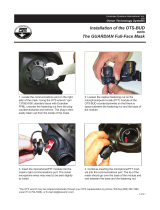Page is loading ...

Ambient Breathing Valve® (ABV®)
Operation and Maintenance Guide
Undersea Systems International, Inc., dba
Ocean Technology Systems
Congratulations on your purchase of the ABV® Ambient Breathing Valve®! The ABV is designed to allow the diver to breathe atmo-
spheric air while on the surface, thereby conserving precious tank air. Before descending, the diver simply closes the ABV.
The Ambient Breathing Valve® (Fig. 1) consists of four major parts: Base (#1), Outer Cap
(#2), Valve Seat (#3) and a Diaphragm (#4). One o-ring (#5) between the base and seat valve
and an o-ring (#6) between the base and outer cap to keep the ABV watertight. A screw (#7)
acts as a stop for the outer cap to keep it from being completely removed.
OPERATION OF THE ABV
- 1 -
Before diving with your ABV, ensure the valve is in good working
order by following the maintenance instructions inlcuded (see
“Maintenance of the ABV”). If you nd any faults in the valve,
do not dive with it: Doing so may pose a safety hazard.
To open the ABV, rotate the cap counterclockwise for comfort-
able ambient air inhalation (Fig. 2). Exhalation will be done
through the second stage of the regulator. Do not rotate the ABV further than the stop-screw allows,
or damage may occur.
To close the ABV, rotate the cap clockwise, and give a rm twist to seat the o-ring (Fig. 3). If a leak
occurs while underwater, tighten the cap further. Always close the ABV before water entry.
CAUTION: If diving in polluted waters, keep the ABV closed until you have been fully decontami-
nated. When storing your FFM, be sure to leave the ABV in the open position to let any residual
water evaporate.
MAINTENANCE OF THE ABV
The following maintenance steps should be done periodically—at least annually, or if there is
any noticeable decline in the ABV’s performance. Follow these steps to maintain your ABV:
Note: FFM skirt removed for clarity.
Outer Cap
1. Remove the stop-screw from the ABV® cap (Fig. 4). You may need to rotate the ABV® cap
to provide easy access to the screw head. Set the screw aside for later reinstallation.
2. Rotate the ABV® cap counterclockwise, and remove the cap completely from the ABV®
base (Fig 5).
Diaphragm
3. To remove the diaphragm from the valve seat, pull diaphragm away from valve while holding
the diaphragm from center (Fig. 6). Once the diaphragm has been removed, examine it for wear
Figure 1: ABV® Components
Figure 3. Closing the ABV
Figure 2. Opening the ABV
Key
(1) ABV® Base (p/n 877001-000)
(2) Outer Cap (p/n 877002-000)
(3) Seat Valve (p/n 877003-000)
(4) Diaphragm (p/n 282035-000)
(5) O-ring (p/n 283036-000)
(6) O-ring (p/n 283021-000)
(7) Screw (p/n 244086-000)
Figure 4. Disassembly

- 2 -
- IMPORTANT SAFETY NOTICE -
(Please read before using the product.)
It is absolutely essential that all divers are properly trained and equipped and fully understand these instructions before attempting
to use the Ambient Breathing Valve® (ABV®).
While the ABV provides divers with surface air breathing, it does not change or eliminate the potential hazards of diving.
NOTE: This instruction sheet and the information contained herein are provided for use as an operation and maintenance guide.
No license or rights to manufacture, reproduce, and/or sell either the instruction sheet or the articles described herein are given.
Ocean Technology Systems reserves the right to change specications without notice.
506084-000 (E)
© Copyright 2011 by Undersea Systems International, Inc., dba Ocean Technology Systems. All rights reserved.
Specications are subject to change without prior notice.
Ocean Technology Systems
3133 W. Harvard Street • Santa Ana • California • 92704 • USA
Toll-free (800) 550-1984 • Telephone • (714) 754-7848 • Fax (714) 966-1639
E-mail [email protected] • Web www.otscomm.com
or deformity. It should lie at on a table top. Replace if damaged.
Seat Valve
4. Using an adjustable pin wrench, rotate the seat valve counterclockwise and remove it com-
pletely from the ABV® base (Fig. 7).
O-ring
5. Carefully remove the o-rings from the grooves on both sides of the ABV® base, and check
that they are not damaged or dried out. Do not use metal tools to remove the o-rings, because
doing so may damage the o-rings and its grooves. Use a credit card or similar object to lift the
o-ring out of the groove. An alternate method is to apply pressure with your thumbs as you move
them away from each other along the edge of the o-ring (Fig. 8). As the o-ring stretches, it will
pop out of the groove at the other end. Lubricate the o-rings with a small amount of high-grade
silicone grease.
Cleaning
6. Clean all surfaces. Ensure that the threads and o-ring seal surfaces are free of dirt and debris.
Reassembly
7. Using needle-nose pliers, pull diaphragm stem into seat valve until you hear a slight popping
sound (Fig. 9).
8. Position the lubricated o-rings into the grooves and seat them with your ngers (Fig. 10).
9. Thread the ABV® seat valve back onto the ABV® base using an adjustable pin wrench. Ensure
there are no gaps between ABV® base and visor.
10. Thread the ABV® outer cap back into the ABV® base. Rotate the ABV® cap approximately
four turns clockwise. The screw hole on the ABV® cap should be in place for the stop-screw.
Reinstall the stop screw. It needs only to be snug—do not overtighten it.
Figure 5. Cap removal
Figure 7. Seat Valve removal
Figure 6. Diaphragm removal
Figure 8. O-ring removal
Figure 9. Re-install
Diaphragm
Figure 10. O-ring
reinstalled
/












